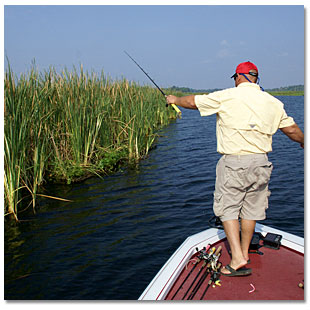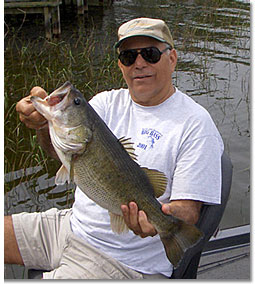
Flipping for Bass in Florida
What is Flipping?
Flipping is a variation of an old Southern Cracker fishing
technique called "Doodle Socking" or "Jigger Poling". Before
we were born, our great great grandfathers learned they could catch
largemouth bass with a long pole, short line and a hook with feathers
or some other decoration. The long pole allowed them to
selectively drop the lure into small holes back in the deepest cover
where the big fish live. Back in the seventies, savvy
anglers adapted this idea to fit tournament rules and "Flipping" was
born.
Why Should I Learn it?
In Florida, the biggest bass in the lake is not swimming around
in a 40 foot hole, she is buried up in the thickest deepest weed bed
she can find. Also, when fish are highly pressured they go to
the same place and don't move if at all. Harris Chain anglers who
fish only outside edges or in the open are missing the majority of
the fish. Flipping allows an angler to make numerous presentations
to the fish where they live. When you go to a Harris Chain
Tournament weigh in and wonder how all those big fish were caught,
odds are they were caught flipping.
 What
Equipment Do I Need for Flipping?
What
Equipment Do I Need for Flipping?
Flipping is done with a long fishing rod, heavy line and a lure pegged to a sinker. Tournament rules limit the rod to no more than 8
1/2 feet. I use a 7 foot rod because the weight of an 8' rod wears me out. Some anglers use braided line
for flipping. I don't like braded line for flipping because it tends to hang on reeds and grass causing the lure to fall
unnaturally, so I use 25 pound mono. The reel doesn't matter much as you only use the reel when fighting the fish. My
favorite lures for flipping are plastic worms, lizards and craws. I use just enough weight so that the lure can fall through the cover
without hanging. I have used many different weight pegging systems over the years including screw in weights, rubber bands and
toothpicks. Today, I use commercially made sinker stops and they work great.
How Is It Done?
Most people stand when flipping. I have back issues, so I flip sitting down or leaning against a post in the boat.
You don't need a fancy bass boat for flipping, but you do need a boat with a casting platform. It is very hard to flip out of a
high sided boat. My 16 1/2 foot aluminum Lowe bass boat works just fine.
There are plenty of YouTube videos, books and websites that can teach you the flipping technique, but here is are the basics. Stand
up and hold the rod at a steep angle toward the fish. Pull off enough line so that the lure is hanging straight down just touching
the water and lock up the reel. Grab the line with your free hand and pull the line away from the rod a comfortable distance. The
lure should rise above the water about 3-4 feet. The idea is to swing the lure in an arch starting close to you and toward the
target. As the lure approaches the target, move your free hand holding the line toward the rod and allow the lure and the weight to
fall on it's own. Do not allow the anything to disrupt the fall of the lure. The action of the lure falling
naturally is what triggers a strike. After a while you will learn to present the lure into the cover with very little splash.
The Fun Part
 Each and every time you make a flipping presentation before you pick up
the lure always check to see if a fish has the lure in it's mouth. Sometimes you will see the grass move when the fish
hits the lure and many times you won't see anything at all. Try to move the lure slowly off the bottom. If you feel any
resistance or movement, set the hook! Once you hook a fish, take up the slack and bring the fish to the boat. Small fish
can normally be swung into the boat without the reel. The real fun in flipping is when you have a really mad 8-9 pound bass on the
end of your rod with only 3 feet of line out. Once this happens to you, it's very addictive.
Each and every time you make a flipping presentation before you pick up
the lure always check to see if a fish has the lure in it's mouth. Sometimes you will see the grass move when the fish
hits the lure and many times you won't see anything at all. Try to move the lure slowly off the bottom. If you feel any
resistance or movement, set the hook! Once you hook a fish, take up the slack and bring the fish to the boat. Small fish
can normally be swung into the boat without the reel. The real fun in flipping is when you have a really mad 8-9 pound bass on the
end of your rod with only 3 feet of line out. Once this happens to you, it's very addictive.
Flipping is one of the most consistently effective big bass
fishing techniques and is well worth the effort to learn. On the Harris Chain, it's a necessity.



 What
Equipment Do I Need for Flipping?
What
Equipment Do I Need for Flipping? Each and every time you make a flipping presentation before you pick up
the lure always check to see if a fish has the lure in it's mouth. Sometimes you will see the grass move when the fish
hits the lure and many times you won't see anything at all. Try to move the lure slowly off the bottom. If you feel any
resistance or movement, set the hook! Once you hook a fish, take up the slack and bring the fish to the boat. Small fish
can normally be swung into the boat without the reel. The real fun in flipping is when you have a really mad 8-9 pound bass on the
end of your rod with only 3 feet of line out. Once this happens to you, it's very addictive.
Each and every time you make a flipping presentation before you pick up
the lure always check to see if a fish has the lure in it's mouth. Sometimes you will see the grass move when the fish
hits the lure and many times you won't see anything at all. Try to move the lure slowly off the bottom. If you feel any
resistance or movement, set the hook! Once you hook a fish, take up the slack and bring the fish to the boat. Small fish
can normally be swung into the boat without the reel. The real fun in flipping is when you have a really mad 8-9 pound bass on the
end of your rod with only 3 feet of line out. Once this happens to you, it's very addictive.